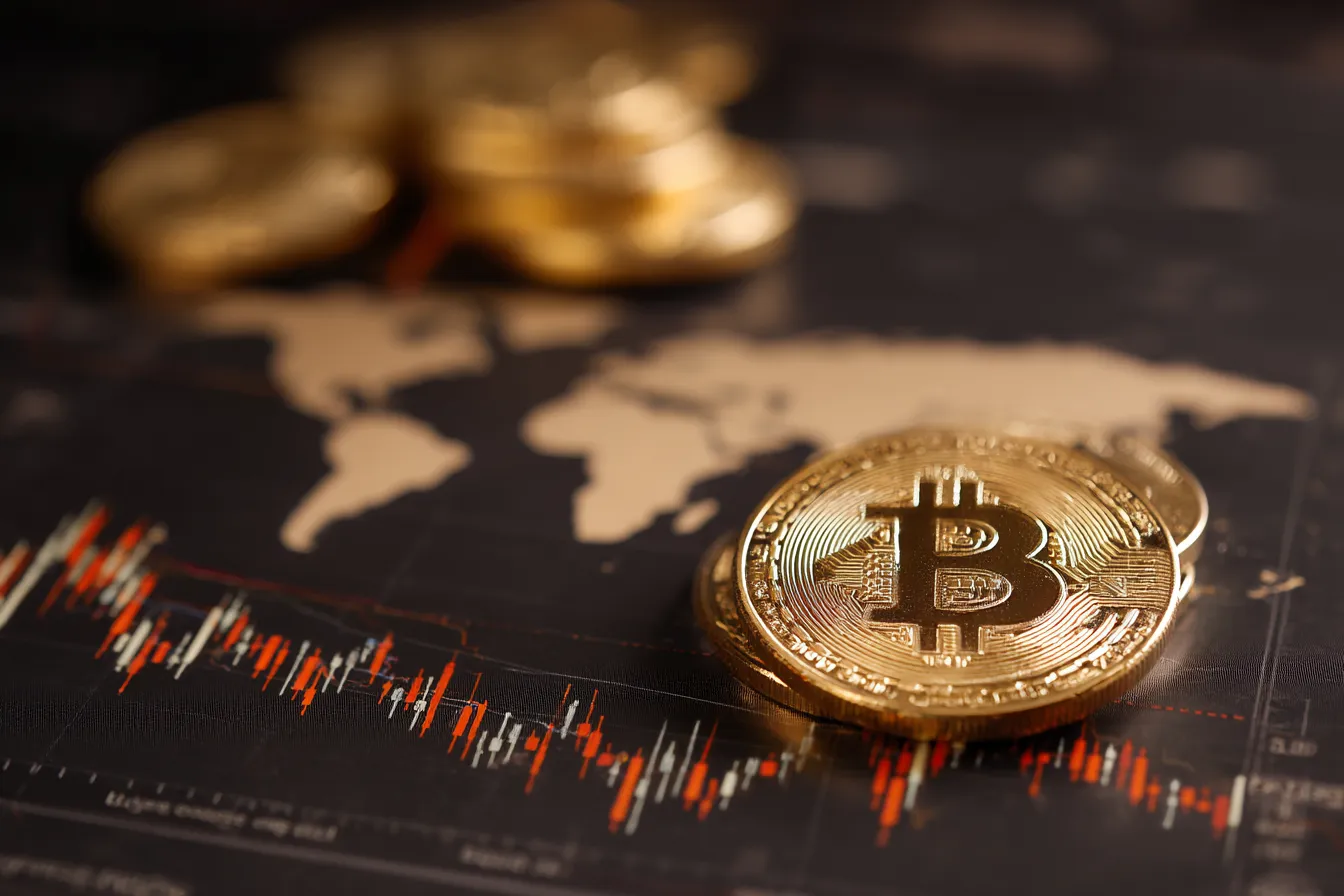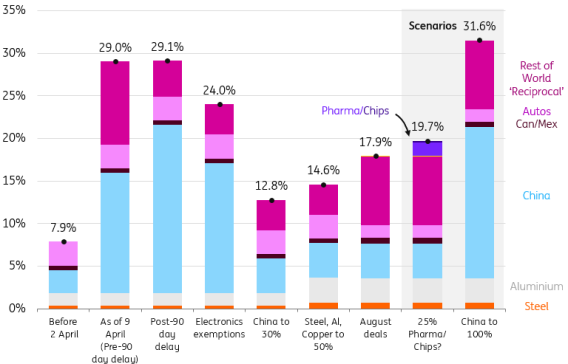When Trade Wars Hit Crypto: A New Stress Test for Digital Assets



After months of calm, crypto markets are experiencing an extremely volatile phase, while Gold continues to perform exceptionally well.
What about the tariff threats from Trump? Significant concern. Trade might catch us off guard once more and prompt the Federal Reserve to initiate a gradual approach to rate cuts.
The sentiment is not quite right. There’s a noticeable sense of unease among many, and it’s creating an atmosphere reminiscent of economic downturns. As we head into the week, the moves are suggesting a concerning trend.
Fears surrounding regional banks have also resurfaced since the blowup in March 2023.
The funding markets in the United States are experiencing significant pressure, and the notoriously opaque private credit markets are causing discomfort among investors.
The level of volatility is increasing. Stocks and oil are on the decline. Cryptos have experienced significant fluctuations. Gold continues to demonstrate remarkable strength, and markets are starting to explore the possibility of more significant Fed rate cuts.
But tariffs could throw everyone off.
Will President Trump act on his promise to implement an additional 100% tariffs on China before his upcoming meeting with President Xi at the end of the month One would assume that the majority of investors would respond negatively.
Indeed, if that were the case, the average tariff rate in the US would rise to 31%, assuming BRN's calculations are accurate, exceeding the figures observed during "Liberation Day."
At that time, it became clear that such levels could not be maintained.

It’s Quite Complex
The market's response to Trump's recent threats is noteworthy. Interesting that there was a reaction, considering that numerous recent tariff threats from Trump have largely gone unheeded.
It suggests that there are concerns regarding the potential for a miscalculation in US-China tensions.
China has demonstrated remarkable strength in the face of US tariffs, supported by alternative demand from other global markets and bolstered by its higher-value export sectors, which show reduced reliance on American consumption.
Market Reaction Bets
Regardless of the rationale, US stocks, cryptos, the dollar, and short-term yields declined following the announcement.
It’s significant that market participants believe additional tariffs would necessitate greater easing from the Federal Reserve, rather than a reduction.
Six months after :Liberation Day," the current indicators reveal a struggling jobs market while inflation remains surprisingly mild.
Friday will put that perspective to the test, as we have some official US data coming in, which is certainly encouraging news, everyone!
Enjoy it while it lasts, as there are minimal indications that Washington will soon resolve the shutdown and the accompanying lack of data.
Tariffs to Show in Inflation?
BRN anticipates that additional price pressure driven by tariffs is on the horizon. During the summer, tariff revenues reached 10% of imports, falling notably short of the anticipated 18% based on the announcements and the import data for 2024. Regardless of the underlying factors, BRN anticipates a positive trend in revenue collection in the months ahead.
Corporations may need to continue absorbing the additional pressure on their margins, or more likely, we will begin to observe an increasing trend of firms transferring those costs to consumers.
The distribution of the tariff impact suggests we are facing a lower, yet more prolonged peak for inflation in the United States.
This indicates that the ongoing disinflationary trends, primarily driven by a deceleration in rental price increases, will become increasingly significant.
That’s precisely why we anticipate an additional four rate cuts from the Fed, exceeding the committee's own projections during the September meeting.
Strategic View
What are the implications if the President's tariffs are deemed unlawful? The anticipation is building as the Supreme Court is set to begin hearing arguments in early November regarding the application of emergency powers to implement extensive national tariffs.
Numerous legal experts have thoroughly considered the situation and believe it is unlikely to favor Trump.
If that does happen and most of the tariffs enacted this year are eliminated, then the president does possess options for substituting them.
Section 122 allows the Administration to impose tariffs of 15% for a duration of up to 150 days. Additional sector-specific tariffs may also be implemented.
Ultimately, the outcome is likely to reflect a reduced effective tariff rate on imports into the US. This could alleviate the strain on inflation and, theoretically, the employment sector as well.
If the markets are accurate in suggesting that the latter is currently more significant to the Fed, it leads to the conclusion that this could result in a reduced likelihood of rate cuts.
A decision against the tariffs enacted through emergency powers would likely lead to significant disruption, as companies would probably be entitled to refunds for the majority of the tariffs they have already paid.
Moreover, ambiguity surrounding the potential replacement tariffs is expected to dampen overall sentiment. That’s before we consider the implications of reduced tariff revenues on the concerning fiscal deficit exceeding 6% in the United States.
Cryptosphere's Response to US-China Trade
The current discussions focused on tariffs between the United States and China signify a pivotal moment for cryptocurrency markets.
Although diplomatic efforts may ignite fresh enthusiasm among investors, the accompanying fluctuations suggest a necessity for careful and well-informed approaches.
When a discussion creates waves across a trillion-dollar industry, the matter is significant in market terms.
The latest talks between US Treasury Secretary Scott Bessent and Chinese Vice Premier He Lifeng reveal significant implications that extend well beyond conventional diplomatic discussions.
Their negotiations indicate more than just simple tariff cuts; they reveal a complex landscape where conventional finance closely intertwines with the dynamic realm of cryptocurrencies.
Market participants are fully cognizant that even a minor change could trigger significant fluctuations in the valuations of digital assets.
The connection between US-China trade negotiations and cryptocurrency movements is not a fleeting trend; it’s a significant relationship shaped by the dynamics of market volatility.
What We Can Learn from Past Trade Wars
Historical trade confrontations indicate a notable trend—digital assets frequently experience an upswing during periods of heightened geopolitical tension.
In the midst of unpredictable tariffs, numerous traders are moving away from conventional fiat currencies, opting instead for the perceived security offered by cryptos.
This essential connection serves as a clear reminder that tariff negotiations extend beyond mere policy discussions; they are significant indicators that could influence the dynamics of digital currency trading and the mindset of investors.
In analyzing Bitcoin and Ethereum, it's essential to recognize their influence as indicators of market sentiment during discussions of trade.
Recent price movements for Bitcoin highlight a clear sensitivity, showcasing significant fluctuations driven by trade-related news.
A thorough examination of past trends reveals that sectors facing tariff issues frequently generate ripple effects across the crypto market.
Individuals putting their money into these digital assets are increasingly seeing them as strongholds of stability amid the unpredictable currents of traditional finance.
This highlights the necessity of keenly monitoring economic changes that influence the value of cryptos.
Diplomacy & Market Reaction
With diplomatic efforts between US and Chinese officials fostering a sense of cautious optimism, there is potential for a renewed sense of confidence among investors.
Remember the turbulent time from 2018 to 2019 during earlier tariff discussions; cryptos experienced intense fluctuations as market participants sought refuge in Bitcoin due to economic uncertainties.
As Secretary Bessent underscores the importance of these discussions, any potential policy changes could trigger swift market responses, placing traders in an environment filled with both lucrative prospects and hidden risks.
A review of past tariff disputes highlights clear trends in market behavior influenced by uncertainty.
The increasing interest in crypto as a protective measure during uncertain periods suggests that ongoing discussions may lead to new capital flowing into digital assets.
As we approach potentially transformative decisions impacting global commerce, wise stakeholders are encouraged to stay strategically flexible. Understanding the complex regulatory environment can open doors to valuable prospects, but it also carries significant risks tied to cryptocurrency
investments.
The intersection of diplomacy and crypto presents a complex landscape filled with both challenges and prospects, urging stakeholders to stay actively involved in this continuously changing story.
As they assess potential scenarios, striking a balance between caution and capitalizing on emerging opportunities will shape their position in this swiftly evolving environment.
Elsewhere
Podcast
Jeff Feng Talks Sei Network's Vision for the Future of Trading
Sei Labs co-founder Jeff Feng unpacks the core value of blockchain as a trading engine, the strategic importance of Singapore's talent pool, and how high-speed infrastructure is quietly powering the next wave of Web3 in gaming, social, and even genetic data.
We're a media partner for the upcoming Singapore Fintech Festival! Use the promo code SFFSMPBH for 20% off all delegate passes at this link !

AI Models Battle in Live Crypto Trading Competition
DeepSeek leads autonomous trading experiment as GPT-5 and Gemini post heavy losses...

Bitcoin Slides Below $110K as ETF Outflows Persist
Your daily access to the backroom...

Beijing Pulls Plug on Ant Group, JD.com Stablecoin Initiatives
Mainland regulators prioritize monetary sovereignty over Hong Kong crypto experimentation...

